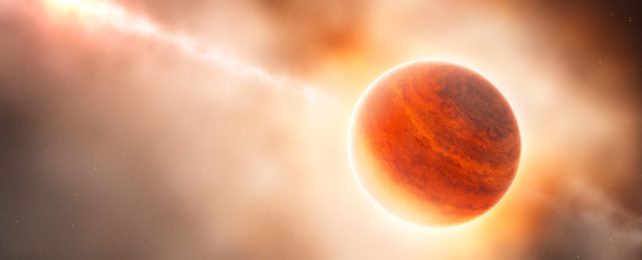A newly weighed exoplanet has left astronomers deeply puzzled.
After taking measurements of a very young Jupiter-sized exoplanet named HD-114082b, scientists have found that its properties don't neatly match either of the two popular models of gas giant planet formation.
Simply put, it's way too heavy for its age.
"Compared to currently accepted models, HD-114082b is about two to three times too dense for a young gas giant with only 15 million years of age," explains astrophysicist Olga Zakhozhay of the Max Planck Institute for Astronomy in Germany.
Orbiting a star named HD-114082 around 300 light-years away, the exoplanet has been the subject of an intense data collection campaign. At just 15 million years old, HD-114082b is one of the youngest exoplanets ever found, and understanding its properties could yield clues as to how planets form – a process not fully understood.
Two types of data are needed for a comprehensive characterization of an exoplanet, based on the effect it has on its host star. Transit data is a record of the way a star's light dims when an orbiting exoplanet passes in front of it. If we know how bright the star is, that faint dimming can reveal the exoplanet's size.
Radial velocity data, on the other hand, is a record of how much a star wobbles in place in response to the exoplanet's gravitational tug. If we know the mass of the star, then the amplitude of its wobble can give us the exoplanet's mass.
For nearly four years, the researchers collected radial velocity observations of HD-114082. Using the combined transit and radial velocity data, the researchers determined that HD-114082b has the same radius as Jupiter – but is 8 times Jupiter's mass. That means that the exoplanet is roughly twice the density of Earth, and nearly 10 times Jupiter's density.
This young exoplanet's size and mass mean that it's highly unlikely to be a super large rocky planet; the upper limit for those is around 3 Earth radii and 25 Earth masses.
There's also a very small density range in rocky exoplanets. Above this range, the body becomes denser, and the planet's gravity starts to retain a significant atmosphere of hydrogen and helium.
HD-114082b is in vast excess of those parameters, which means it's a gas giant. But astronomers just don't know how it got that way.
"We think that giant planets can form in two possible ways," says astronomer Ralf Launhardt of MPIA. "Both occur inside a protoplanetary disk of gas and dust distributed around a young central star."
The two ways are referred to as a 'cold start' or a 'hot start'. In a cold start, the exoplanet is thought to form, pebble by pebble, from debris in the disk orbiting the star.
The pieces are attracted, first electrostatically, then gravitationally. The more mass it gains, the faster it grows, until it's massive enough to trigger runaway accretion of hydrogen and helium, the lightest elements in the Universe, resulting in a massive gaseous envelope around a rocky core.
Given the gasses lose heat as they fall towards the planet's core and form an atmosphere, it's seen as the relatively cool option.
A hot start is also known as disk instability, and it's thought to occur when a swirling region of instability in the disk directly collapses in on itself under gravity. The resulting body is a fully-formed exoplanet that doesn't have a rocky core, where the gasses retain more of their heat.
Exoplanets that experience a cold start or a hot start should cool at different rates, producing distinct characteristics that we should be able to observe.
The properties of HD-114082b don't fit the hot start model, the researchers say; its size and mass are more consistent with core accretion. But even then, it's still just too massive for its size. Either it has an unusually chonky core, or something else is going on.
"It's much too early to abandon the notion of a hot start," Launhardt says. "All we can say is that we still don't understand the formation of giant planets very well."
The exoplanet is one of three we know of that are younger than 30 million years, for which astronomers have obtained radius and mass measurements. So far, all three seem inconsistent with the disk instability model.
Obviously, three is a very small sample size, but three for three suggests that perhaps core accretion may be the more common of the two.
"While more such planets are needed to confirm this trend, we believe that theorists should begin re-evaluating their calculations," Zakhozhay says.
"It's exciting how our observational results feed back into planet formation theory. They help improve our knowledge about how these giant planets grow and tell us where the gaps of our understanding lie."
The research has been published in Astronomy & Astrophysics.
